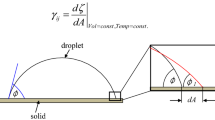Abstract
Electrowetting refers to an electrostatically induced reduction in the contact angle of an electrically conductive liquid droplet on a surface. Most designs ground the droplet by either sandwiching the droplet with a grounding plate on top or by inserting a wire into the droplet. Washizu and others have developed systems capable of generating droplet motion without a top plate while allowing the droplet potential to float. In contrast to these designs, we demonstrate an electrowetting system in which the droplet can be electrically grounded from below using thin conductive lines on top of the dielectric layer. This alternative method of electrically grounding the droplet, which we refer to as grounding-from-below, enables more robust droplet translation without requiring a top plate or wire. We present a concise electrical-energy analysis that accurately describes the distinction between grounded and non-grounded designs, the improvements in droplet motion, and the simplified control strategy associated with grounding-from-below designs. Electrowetting on a single planar surface offers flexibility for interfacing to liquid-handling instruments, utilizing droplet inertial dynamics to achieve enhanced mixing of two droplets upon coalescence, and increasing droplet translation speeds. In this paper, we present experimental results and a number of design issues associated with the grounding-from-below approach.










Similar content being viewed by others
References
Chen C, Fabrizio EF, Nadim A, Sterling JD (2003) Electrowetting based microfluidic devices: design issues. ASME Summer Bioengineering Conference
Cho SK, Moon HJ, Kim CJ (2003) Creating, transporting, cutting, and merging liquid droplets by electrowetting-based actuation for digital microfluidic circuits. J Microelectromech Syst 12:70–80
Gascoyne PRC, Vykoukal JV,. Schwartz JA, Anderson TJ, Vykoukal DM,. Current KW, McConaghy C, Becker FF, Andrews C (2004) Dielectrophoresis-based programmable fluidic processors. Lab on a Chip 4:299–309
Hu H, Larson RG (2002) Evaporation of a sessile droplet on a substrate. J Phys Chemy B 106:1334–1344
Jones TB (2002) On the relationship of dielectrophoresis and electrowetting. Langmuir 18:4437–4443
Jones TB, Gunji M, Washizu M, Feldman MJ (2001) Dielectrophoretic liquid actuation and nanodroplet formation. J Appl Phys 89:1441–1448
Kang KH (2002) How electrostatic fields change contact angle in electrowetting. Langmuir 18:10318–10322
Lee J, Moon H, Fowler J, Schoellhammer T, Kim CJ (2002) Electrowetting and electrowetting-on-dielectric for microscale liquid handling. Sensors Actuators a – Physical 95:259–268
Mugele F, Baret JC (2005) Electrowetting: from basics to applications. J Phys-Condensed Matter 17:R705–R774
Pamula V, Pollack MG, Paik P, Ren H, Fair RB (2005) US Patent 6,911,132
Pollack MG, Fair RB, Shenderov AD (2000) Electrowetting-based actuation of liquid droplets for microfluidic applications. Appl Phys Lett 77:1725–1726
Pollack MG, Shenderov AD, Fair RB (2002) Electrowetting-based actuation of droplets for integrated microfluidics. Lab on a Chip 2:96–101
Pollack MG, Paik PY, Shenderov AD, Pamula VK, Dietrich FS, Fair RB (2003) Investigation of electrowetting-based microfluidics for real-time PCR applications. μTAS
Seyrat E, Hayes RA (2001) Amorphous fluoropolymers as insulators for reversible low-voltage electrowetting. J Appl Phys 90:1383–1386
Shapiro B, Moon H, Garrell RL, Kim CJ (2003) Equilibrium behavior of sessile drops under surface tension, applied external fields, and material variations. J Appl Phys 93:5794–5811
Srinivasan V, Pamula VK, Pollack MG, Fair RB (2003) Clinical diagnostics on human whole blood, plasma, serum, urine, saliva, sweat, and tears on a digital microfluidic platform. μTAS
Sterling JD (2003) US Patent Application 20030164295
Torkkeli A, Haara A, Saarilahti J, Harma H, Soukka T, Tolonen P (2001) Electrostatic transportation of water droplets on superhydrophobic surfaces. Proc 14th IEEE Int Conf MEMS 475–478
Torres FE, Kuhnt P, De Bruyker D, Bell AG, Wolkin MV, Peeters E, Williamson JR, Anderson GB, Schmitz GP, Recht MI, Schweizer S, Scott LG, Ho JH, Elrod SA, Schultz PG, Lerner RA, Bruce RH (2004) Enthalpy arrays. Proc Natl Acad Sci USA 101:9517–9522
Vallet M, Vallade, Berge B (1999) Limiting phenomena for the spreading of water on polymer films by electrowetting. Eur Phys J B 11:583–591
Washizu M (1998) Electrostatic actuation of liquid droplets for microreactor applications. IEEE Trans Ind Appl 34:732–737
Yi UC, Kim CJ (2005) EWOD actuation with electrode-free cover plate. transducers ‘05: The 13th international conference on solid-state sensors, actuators and microsystems, Seoul, Korea
Acknowledgements
The authors wish to acknowledge Robert Melendes and Ming Lu for their assistance and microfabrication expertise, and Dr. Reza Miraghaie for the high-speed image of electrowetting droplet shape oscillations. We also acknowledge NIH/GMS for a mentored quantitative research career development award to James D. Sterling (Grant No. 5K25GM063837), and NIH for the Small Business Innovation Research Awards (Grant No. 2R44GM067469-02).
Author information
Authors and Affiliations
Corresponding authors
Rights and permissions
About this article
Cite this article
Cooney, C.G., Chen, CY., Emerling, M.R. et al. Electrowetting droplet microfluidics on a single planar surface. Microfluid Nanofluid 2, 435–446 (2006). https://doi.org/10.1007/s10404-006-0085-8
Received:
Accepted:
Published:
Issue Date:
DOI: https://doi.org/10.1007/s10404-006-0085-8




